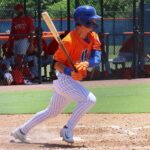
While the New York Mets have done themselves few favors with their anemic offense this season, a lot of their inconsistencies can ultimately be traced to the results they’ve gotten out of the bullpen.
Thus far, Met relievers have compiled a 4.81 FIP (last in the NL) and 1.41 WHIP (13th) while averaging 1.46 HR/9 against a paltry 37.9 percent ground ball rate (both of which also rank last).
Of the four frontline arms the team boasted coming into 2018, Jerry Blevins is the only one currently on the active roster. AJ Ramos‘ nightmare season (6.41 ERA, 6.9 BB/9) came to an end after it was revealed he had torn his labrum, and Anthony Swarzak (6.00 ERA, 2.1 HR/9) is currently on the disabled list for the third time this year, this time dealing with shoulder inflammation.
Jeurys Familia is an Oakland Athletic, and Paul Sewald – the only regular reliever from last year’s squad – has struggled horribly to get outs (7.71 ERA, 1.93 WHIP in the second half).
Sewald’s issues, in particular, have come to symbolize the general trajectory of the bullpen, and furthermore the team, through what looks to be another losing season.
Through April 29, the sidearmer had held batters to a .191/.235/.255 line while striking out 17 batters in 13.2 innings of work. His 1.98 ERA wasn’t all that different from the collective 3.39 that the Mets (who were then 17-9) had gotten out of their bullpen.
He had only made seven appearances to this point, thereby averaging just under two frames per outing.
Fast-forward to July 8, and Sewald’s numbers were much more reflective of the team we’ve had to hopelessly watch since the middle of May.
At this point, Sewald had a 5.17 ERA, his opponent OPS had climbed all the way up to .787, and just a day later, the righty was optioned to Triple-A Las Vegas to straighten himself out.
Something about his fall from grace felt disheartening, and the statistics ultimately validate that.
Prior to the beginning of May, Sewald had thrown over an inning in six of his seven appearances.
Over the next two months and 20 outings, he worked the long-relief shift just 10 times. It was the perfect combination of overuse and misuse that buried Sewald, and shortly thereafter the rest of the bullpen.
Seth Lugo had seen similar success across his first 14.1 innings and nine appearances, stranding a bullpen-leading 83.3 percent of baserunners while posting a 48.7 percent ground ball rate third behind Familia and fellow former-starter Robert Gsellman (59.6 percent).
Gsellman himself may have been enjoying his new role in the bullpen the most, as his 1.80 ERA, 1.82 FIP, and 3.17 K/BB ratio could attest.
Between the two starters and Sewald – at least early on – the concept of stretching and weaving innings out of arms that could handle the workload was thriving, and the team was winning.
Unfortunately, both pitchers endured similarly frustrating regression as the season wore on.
Lugo was dropped into the rotation to fill in for an injured Noah Syndergaard from May 31 through June 25. Gsellman had to pitch in 10 of these 22 games in his place, allowing 10 runs as he buckled under a far more strenuous role.
Overall, the bullpen essentially burst into flames. Combining for 69 appearances, Met relievers put up a 5.99 ERA (29th in the majors) while walking 42 batters over just 76.2 innings. Hansel Robles, Tim Peterson, and Chris Beck were asked to work middle-relief innings as Mickey Callaway tried his best to patch wins together.
With the additions of such young arms as Tyler Bashlor, Drew Smith, and Daniel Zamora, the Mets have a bullpen that, to some extent, can be trusted late in games. Between August 8 and August 25 (a stretch in which the team has gone 13-7, admittedly omitting the 14-run blowup against the Washington Nationals), Met relievers were third in the major leagues with a 2.75 ERA, second with a 1.04 WHIP, and first with a walk rate of just 4.5 percent.
Lugo, Gsellman, and even Corey Oswalt have been chipping in as long-relievers in this time, combining for a 1.39 ERA and .183/.205/.254 opponent line. They’re also averaging a WPA of 0.07 per game.
Having the ideal mixture of solid mid-relief options and flexible, successful innings-eaters, the Mets are (theoretically, at least) one power arm away from a strong bullpen.
Granted, there’s a lot that can also go wrong.
Closers and other high-leverage relievers often fizzle out while some unlikely arms rise from the ashes to drive a team in ways that numbers themselves sometimes fail to predict – as the case has been in favor of Kirby Yates and Blake Treinen and against the likes of Ken Giles and Hector Neris.
Make no mistake: sowing seeds and reaping a harvest from relievers is an unpredictable and often unforgiving endeavor.
Hurlers like Brad Peacock, Collin McHugh, Yusmeiro Petit, Chad Green, Archie Bradley, Kenta Maeda, Michael Lorenzen, and Adam Conley – all of whom had extensive professional careers as starting pitchers – make up a handful of the game’s most dominant long-relievers across the past two years, with some even making confident transitions back into the rotation.
Nonetheless, almost all of these relievers represent some of the game’s best bullpens, most of which belong to contending, dynamic teams.
Whether they were put into these spots because they couldn’t handle starting or were simply needed to shore up the back-end of the pitching staff, long relievers have slowly become a staple in some of the more successful pitching staffs.
Overuse is always an acute concern that is perhaps exacerbated by the Mets’ own misfortunes.
It should still be noted, however, that just two of the aforementioned relievers has missed time with an injury this year – with Lorenzen’s month-long recovery from a shoulder strain in March the only notable ailment.
What’s more, Oswalt is the only such pitcher in the Mets’ organization who has dealt with any injuries this season – a lat injury that cost him two starts in Las Vegas.
Another sound example of an innovative bullpen design, the Tampa Bay Rays have accumulated the most relief innings in baseball (641.1), and lead the second-best San Diego Padres by over a hundred despite totaling just four more appearances.
All in all, each reliever averages an inning and two-thirds, yet Tampa still comes in with the fifth-lowest ERA (3.66), third-lowest WHIP (1.21), and second-lowest groundball rate (45.3 percent) in the American League.
Perhaps the most satisfying result of what manager Kevin Cash has described as an “opener” project? Not a single reliever that has participated has been sidelined with an arm injury.
In other words, there’s really no reason to worry about the side effects of storing durable, malleable pitchers in the bullpen over intimidating flamethrowers that can only give an inning on a nightly basis.
The only thing to fear in this sort of alignment is failing to carry it out altogether. The Mets had a .714 OPS (18th in the majors) and 3.86 starter ERA (21st) through their first month of baseball. The team was still 17-9, and there was a clear reason why.















